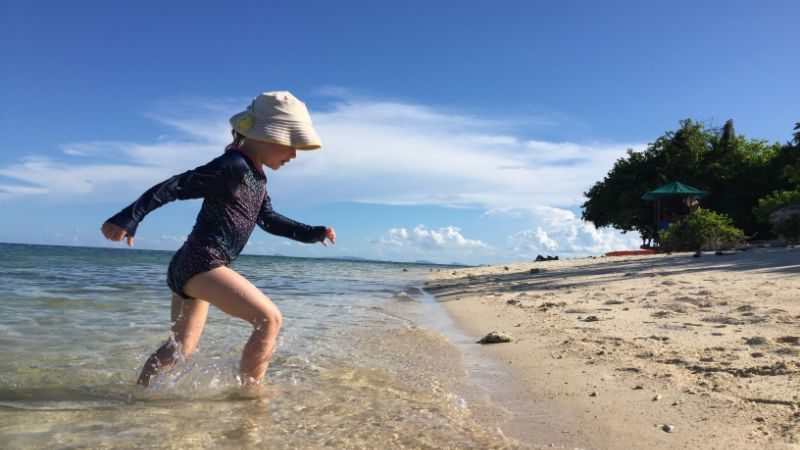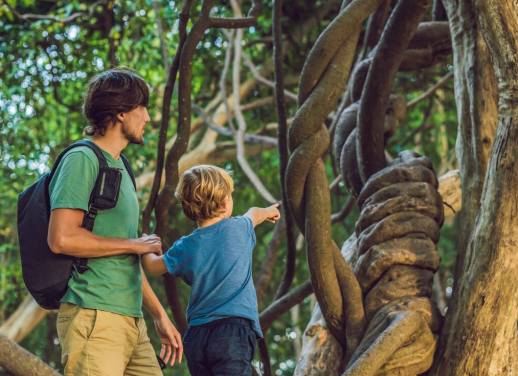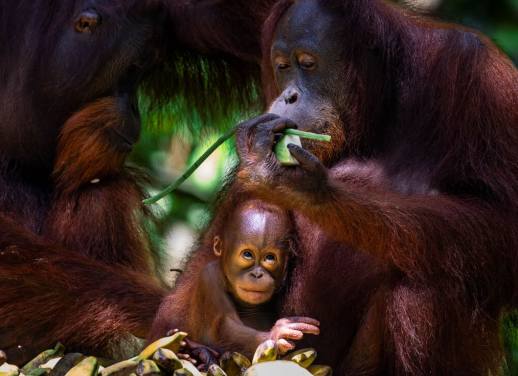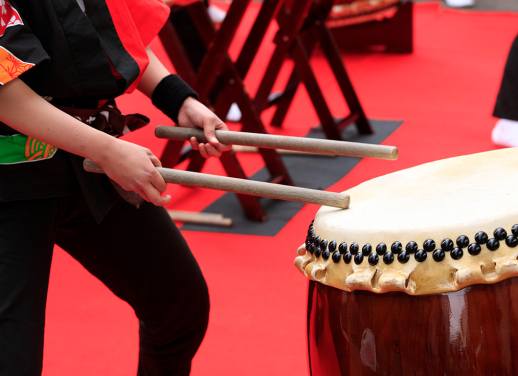My daughter’s obsession with the environment started two years ago. She had just turned four, and was learning about recycling, sustainability, veggies gardens and composting at Kinder; the teachers were educating the kids about how to save the planet in a way they could understand.
It worked. Every day, she’d come home and trawl through the rubbish, looking for tins, jars and cartons with the recycling logo on the label, loudly exclaiming “Recycling is important for planet!!”. She learnt about what we could put on our vegetable garden at home, and what should go into rubbish. And she started being a lot more positive about using recycled paper and materials (like egg cartons, cereal boxes, and old Kinder newsletters) in her arts and crafts projects. I loved seeing her passion for the planet, and I wanted to take that interest further than just recycling and composting at home.
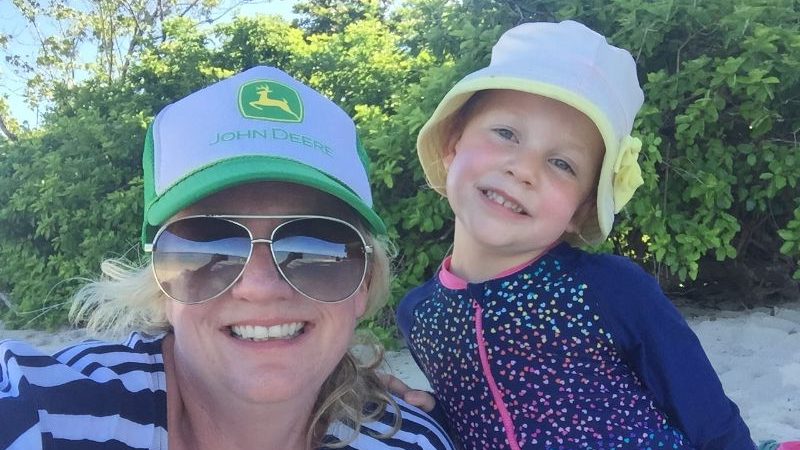
A family photo on Turtle Island.
I was already planning a trip for the two of us to South East Asia, and Borneo seemed to be the perfect destination to start the conversation. I first visited in 2001, and saw orangutans in the wild; I remember watching in fascination as these long-limbed primates swung through the trees and foraged for food. But I also remember a feeling of dread; even almost 20 years ago, deforestation was rife, and I couldn’t help but wonder how these creatures could survive.
Here are three places that’ll help parents and carers teach their kids about environmental conservation in a fun (and educational) way on Intrepid’s 11-day Borneo Family Holiday.
1. KOPEL at Kinabatagan River

The simple jungle huts at KOPEL.
When you drive between cities and rural outposts in Borneo, the effects of deforestation become evident very quickly. It’s understandable why an organisation like KOPEL is critical to the country. Established in 2001 by a former Intrepid leader, KOPEL is a local community-run conservation organisation; its aim is to provide villagers with the means of making a living sustainably from the forest. Through KOPEL, the community are actively involved in growing seedlings and replanting degraded forest areas. In doing so, they are helping to restore forest corridors and increase the habitat for wildlife in the Lower Kinabatangan Region.
LEARN MORE ABOUT SUSTAINABILITY AND THE ENVIRONMENT ON INTREPID’S 11-DAY BORNEO FAMILY HOLIDAY
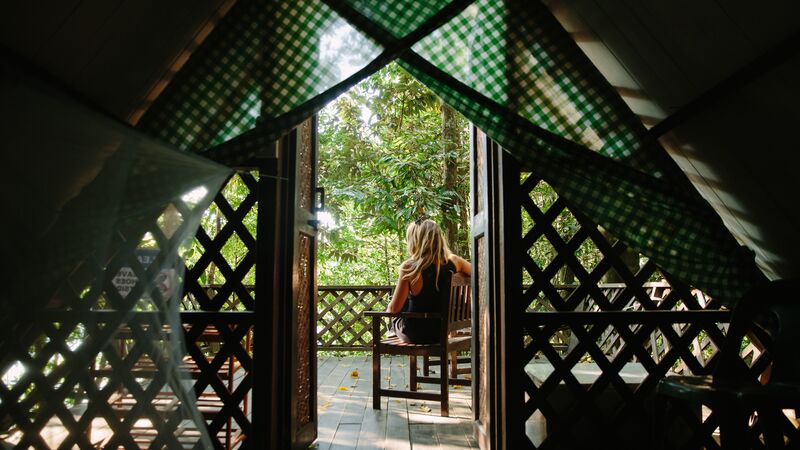
Looking out of our huts.
On day four of our adventure, we spent a night in one of KOPEL’s jungle huts. The simple huts, on stilts, are scattered throughout the forest. We slept on mattresses on the floor under mosquito nets, and listened to the sounds of the jungle outside. The huts have no running water or electricity; instead, they rely on water tanks and guests bringing head torches (solar power is part of KOPEL’s future plans). My daughter loved the adventure of sleeping in the forest and, as it was a device-free zone, we could talk about the environment and what would happen to the wildlife if we cut down all the trees.
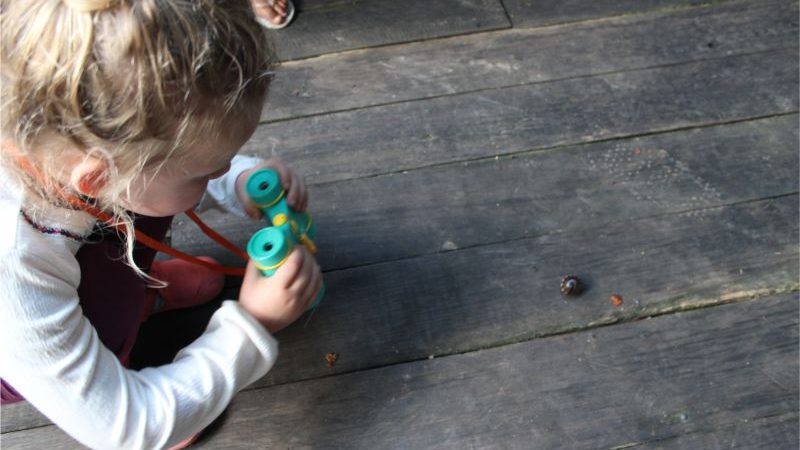
My daughter was endlessly fascinated by the smallest things.
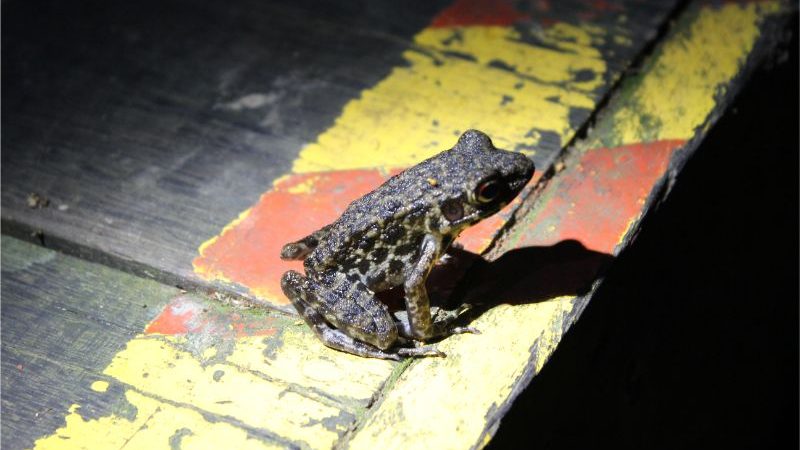
One of our new friends.
Staying in a place like this really gives you a sense for how important the forest is to the area; we spent our time hanging out with small troops of long-tailed macaques, who regularly swung by the dining area; we searched for lemurs as they flew through nearby trees, and crouched down to the forest floor to see colourful frogs, up close and personal. In the evening, as we chatted to a group of Japanese research students, a shy Malay civet cat wandered into camp. The cats are another animal negatively affected by timber harvesting in Borneo, as the forest is their preferred habitat.
EXPLORE OUR RANGE OF ADVENTURES THROUGH BORNEO HERE
2. Turtle Island Marine Park

Our first view of Turtle Island.
On the sixth day of our family adventure, we travelled by speedboat to Turtle Island, a conservation area in the Sulu Sea for green turtles and hawksbills, both endangered species. The park only accommodates 50 tourists at a time, which ensures the turtles aren’t disturbed, and the island is preserved and not overrun by tourists.
During the day, the white sandy shores are a great place to sit, relax, and splash about. There’s an informative museum on the island, which the kids loved. But the real action happens when the sun goes down; every night, the green turtles come ashore to lay their eggs, and we were able to witness this amazing natural wonder.
INTERESTED IN FAMILY TRAVEL? CHECK OUT OUR FULL RANGE OF ADVENTURES HERE
As soon as it started to get dark, we all gathered in the dining hall to wait for a call from the island’s rangers; the anticipation in the room was truly electrifying. We all had to accept that we were on turtle time, which definitely tested one or two impatient children (including mine!). At 8.25pm, the ranger burst in amid great excitement: a mother turtle was ashore; it was go time!
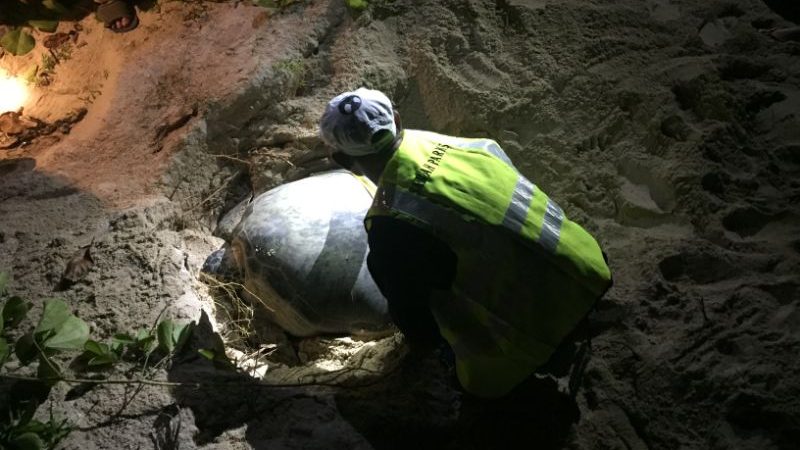
A ranger tends to one of the mothers.
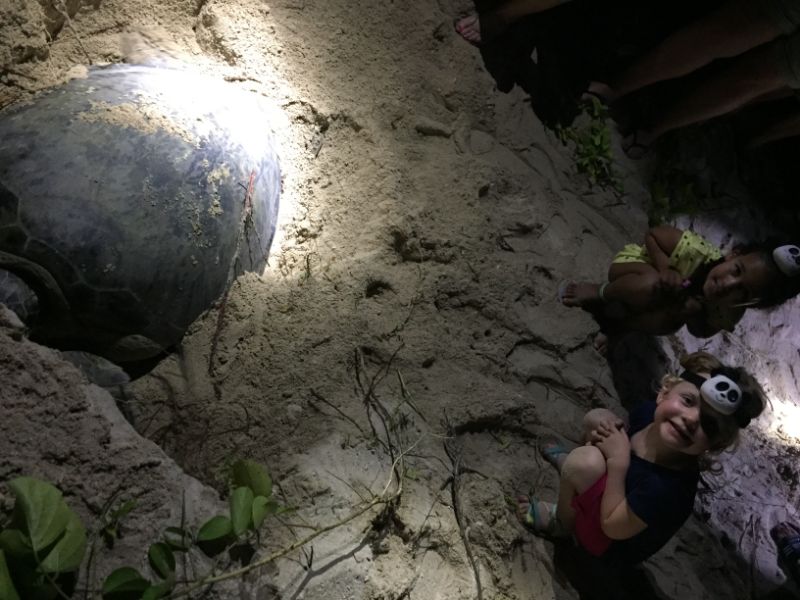
My daughter was THRILLED to be this close to the action!
With head torches on, we walked quickly and quietly to where a rather large (94cms) mother turtle lay buried in the sand. Visitors aren’t allowed to view the egg laying, as any distractions can interfere with the process; when we arrived, the rangers were recording her details and collecting the eggs. Then we went to the hatchery and watched the rangers put the eggs into man-made nests for them to incubate, and then hatch! The incubation period is between 45-60 days and the temperature of the sand determines the sex of the turtle (the hotter the sand, the more likely a female turtle will be born). The last activity of the evening was the most exciting for everyone: releasing the babies. You’re close enough to see them, however no contact is allowed (naturally), and flash photography is strictly prohibited.
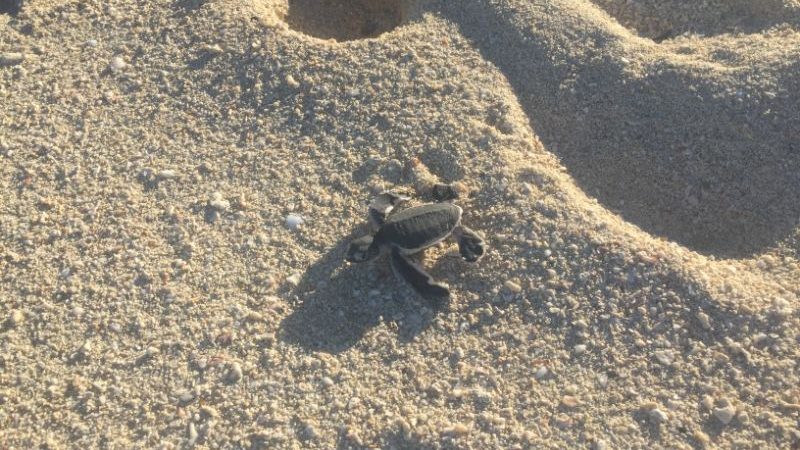
Watching the hatchlings making their first journey.
The island is a very vulnerable place; thousands of eggs and animals lost each year to turtle hunters. Marine turtles play a critical role in maintaining Malaysia’s ocean ecosystems and habitats, so it’s no wonder the island has its own coast guard to protect these magnificent animals.
SUBSCRIBE TO INTREPID’S NEWSLETTER FOR TRAVEL TIPS, COMPETITIONS, GIVEAWAYS & MORE
3. Sepilok Orangutan Rehabilitation Centre
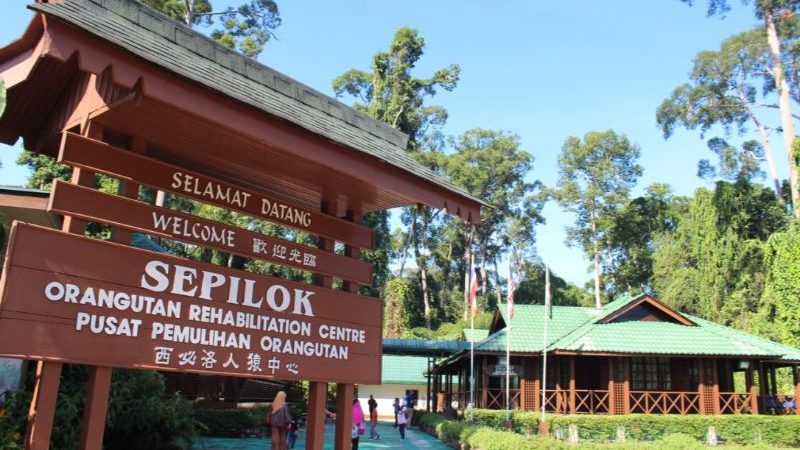
Arriving at Sepilok.
On the drive to Sepilok, you can’t help but notice large gaps in the forest where tree upon tree has been cut down. And you wonder what will happen if it doesn’t stop.
The Sepilok Orangutan Rehabilitation Centre currently has between 60 and 80 orangutans living freely in the reserve. It opened in 1964, with the sole purpose to help rehabilitate orphaned creatures. Like humans, orangutans rely on their mothers for important life skills. Most will live with their mothers for 5-6 years, but without them, they need to be taught how to cope in the wild. The centre has a nursery where rescued babies are taken to be cared for and taught how to climb, forage for food, and build nests.
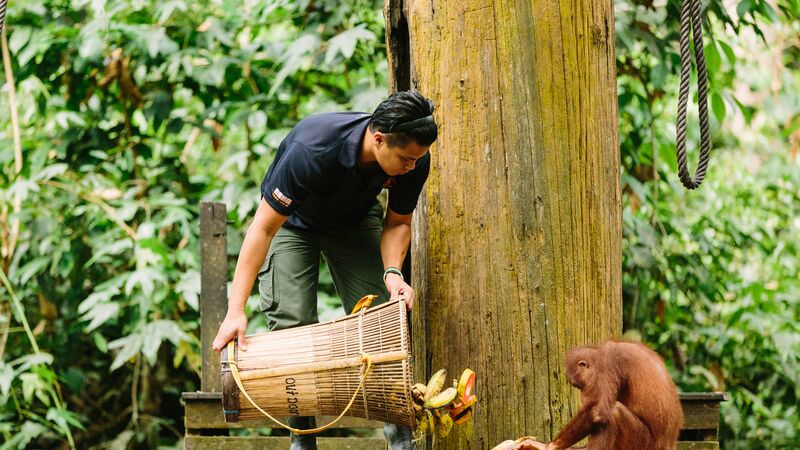
The kids loved watching the orangutans have their morning tea!
Fanning off the heat and humidity of the forest, we ventured into the Forest Reserve, eyes peeled and ears open! We didn’t have to wait long; a rustle of leaves up ahead and a hand signal from our local ranger told us we were in company. Soon we could see two young orangutans, swinging in the trees above our heads, dropping leaves as they went. On the walk to the nursery, we were lucky enough to see a total of eight more, playfully moving through the jungle. My daughter marvelled at how agile the babies were, swinging, somersaulting and tumbling.
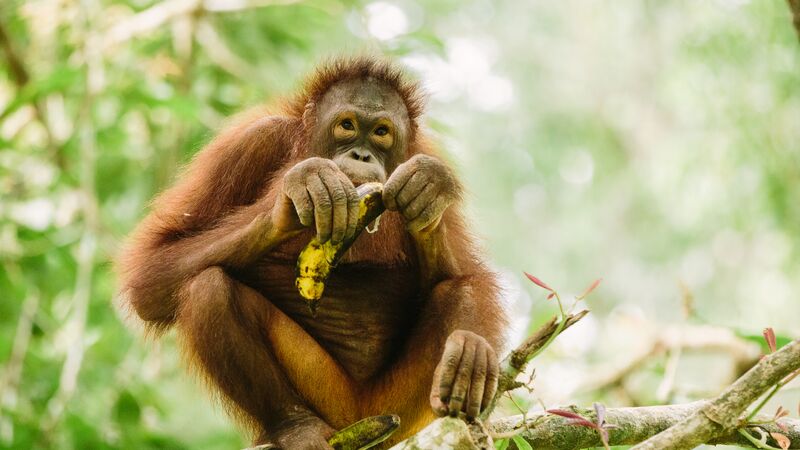
Banana-time!
Both Sumatran and Bornean orangutans are classified as critically endangered, according to the International Union for the Conservation of Nature and Natural Resources and it’s believed that extinction in the wild is likely in the next 10 years. With that in mind, being able to see them thriving in their natural habitat while we still can was a very special experience.
We might be biased, but a great (and fun!) way to educate your kids about the environment is on a family adventure in Borneo. Check out our range of family-friendly trips here.

